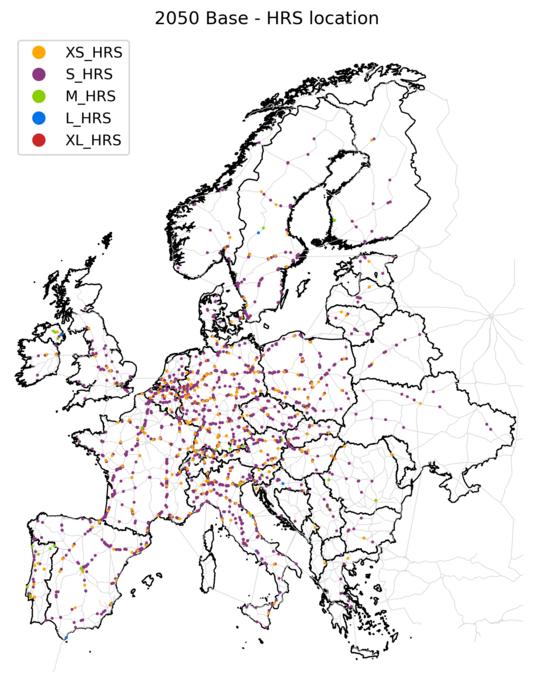
As Europe positions itself to meet ambitious climate goals, the rollout of hydrogen infrastructure has become a pivotal topic of discussion. New research from the Chalmers University of Technology sheds light on the nuances of implementing hydrogen refueling stations across the continent. With the European Union (EU) mandating the establishment of these stations at regular intervals, there is increasing scrutiny about their planned distribution and efficacy. This study unveils critical gaps in current regulations, emphasizing the repercussions of suboptimal planning that could translate to financial losses in the years ahead.
The framework behind the EU’s Alternative Fuels Infrastructure Regulation (AFIR) sets the stage for an expansive network of hydrogen refueling stations. By 2030, member states are required to ensure that these stations are positioned every 200 kilometers on major highways and near urban centers. This ambitious initiative is designed to support the integration of hydrogen-powered vehicles into the transportation ecosystem, facilitating a much-needed transition away from fossil fuel dependence. However, the Chalmers study presents a sobering reality; while these regulations provide a foundational structure, they may significantly fail to capture the true demand for hydrogen infrastructure.
Analyzing data derived from an extensive array of 600,000 freight routes throughout Europe, researchers from Chalmers applied an advanced modelling technique to forecast where hydrogen infrastructure needs will grow. Predictions extending to 2050 reveal alarming discrepancies between the EU’s broad policy guidelines and the actual needs dictated by future traffic patterns. Among the compelling findings, the study calculates that refueling capacity requirements in France could exceed the established EU guidelines by a factor of seven, a clear indicator of the inadequacies in the current regulatory framework that relies heavily on distance alone.
.adsslot_mAoay1YS7W{ width:728px !important; height:90px !important; }
@media (max-width:1199px) { .adsslot_mAoay1YS7W{ width:468px !important; height:60px !important; } }
@media (max-width:767px) { .adsslot_mAoay1YS7W{ width:320px !important; height:50px !important; } }
ADVERTISEMENT
This emphasis on distance over actual traffic volumes and regional transportation patterns has profound implications in countries with less robust traffic flow like Bulgaria, Romania, and Greece. These nations are currently compelled to invest in extensive infrastructure with expectations of usage that may never fully materialize, resulting in wasted expenditure amounting to millions of euros annually. Consequently, the research underscores a critical need for a more adaptive approach in the rollout of hydrogen refuelling stations, one that considers the unique economic climates and transportation needs of each country instead of adhering to a one-size-fits-all strategy.
In enhancing the accuracy of demand predictions, the research admits the significance of geographical factors, arguing that terrain types and gradients can greatly affect the energy requirements of hydrogen-powered trucks. While common models have typically operated on an assumption of average energy consumption per kilometer, the reality is far more complex. Variables like slope, speed, and distance significantly alter these calculations, and thus a more tailored simulation provides a clearer picture of genuine infrastructure needs, leading to efficient and financially viable solutions.
Focusing primarily on long-haul transportation, the study argues that routes exceeding 360 kilometers are most appropriate for hydrogen solutions. Currently, shorter journeys are more likely to be fulfilled by battery-operated vehicles due to advancements in battery technology and performance. This delineation between short and long-range requirements is crucial for ensuring that investments in hydrogen infrastructure are well-informed and strategically placed, fostering sustainability in both environmental and economic terms.
Looking beyond immediate compliance with AFIR, the researchers are calling for a future-facing approach to investment. By analyzing projected demand over a longer time frame, they aim to safeguard the long-term viability of hydrogen infrastructure. This aligns with ongoing discussions at both local and EU levels, where policymakers are increasingly receptive to considerations raised by the study. There is aspiration among the researchers to influence regulatory developments that reflect the diverse circumstances of EU member states, particularly informed by the unique demands they face in transitioning toward hydrogen as a fuel source.
The implications of intelligent planning that stems from this research extend into a broader dialogue on the sustainability of hydrogen infrastructure investments. For instance, with future developments anticipated, the Chalmers team hopes to contribute to a progressive evolution of AFIR that not only meets current demands but anticipates the complexities of future transportation networks. As countries like Sweden navigate the intricacies of hydrogen infrastructure, the efficiency of investments will hinge on embracing models that reflect specific regional requirements rather than blanket mandates.
Moreover, the findings of this research have transcended academic circles, prompting political dialogues that extend from Sweden to broader EU forums. The insights gleaned from this comprehensive analysis serve as foundational guidance for assessing the AFIR framework in upcoming evaluations, notably set for 2026. The researchers’ objective is to influence legislation that harmonizes the development of a collaborative and economically viable network of refueling stations, ultimately strengthening the marketplace for heavy-duty hydrogen vehicles.
In the face of climate change challenges, this research represents a crucial step in aligning energy policy with dynamic market demands. It stands as a blueprint for how infrastructure can be strategically developed, recognizing that technological advancements in hydrogen use must be mirrored by a robust, demand-driven refueling network. The proactive stance taken by the Chalmers team highlights the necessity for continuous evaluation and adaptation in policy frameworks.
This progressive outlook is reflective of the larger narrative surrounding hydrogen as a preferred alternative fuel. With increasing momentum for zero-emission transportation options, robust hydrogen infrastructure represents a key challenge, and opportunity, in radically transforming the transportation landscape. Highlighting the need for substantive dialogue between research, policy, and implementation serves to bring a collaborative vision to fruition.
Conclusively, the meticulous work executed by the Chalmers University team signals a decisive step forward in refining our approach to hydrogen infrastructure. It emphasizes a commitment to not only fulfill immediate legislative requirements but also to secure a future where hydrogen can play a central role in energy transition within the transportation sector in Europe, ensuring the economic sustainability and environmental integrity of these ambitious objectives.
Subject of Research: Geospatial distribution of hydrogen demand and refueling infrastructure for long-haul trucks in Europe
Article Title: Geospatial distribution of hydrogen demand and refueling infrastructure for long-haul trucks in Europe
News Publication Date: 15-May-2025
Web References: https://doi.org/10.1016/j.ijhydene.2025.04.257
References: International Journal of Hydrogen Energy
Image Credits: Credit: Chalmers
Keywords
Hydrogen fuel, Transportation infrastructure, Energy resources, Fuel.
Tags: Alternative Fuels Infrastructure RegulationChalmers University of Technology researchEU member states hydrogen mandatesEuropean Union climate goalsfinancial losses from hydrogen stationsfossil fuel dependence reductionfreight routes analysishydrogen infrastructure planninghydrogen refueling stationshydrogen-powered vehicles integrationregulatory gaps in hydrogen deploymenttransportation ecosystem transition



